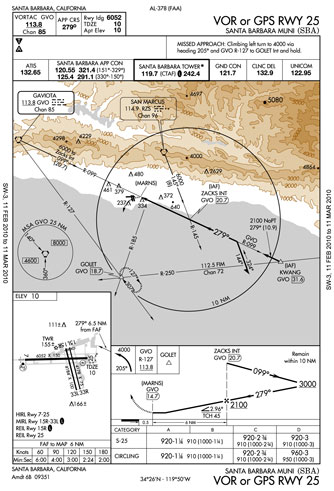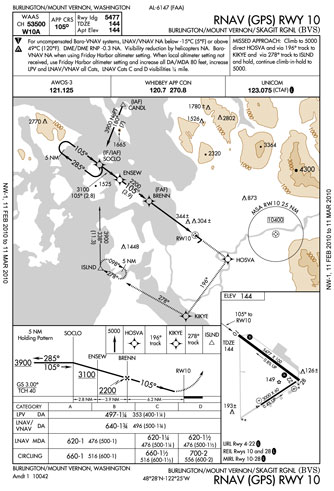
| Number 363 | March 2010 |

“Cone of confusion” is one of those versatile aviation terms that may be applied to conditions other than those intended. In a strict sense, the term refers to a cone-shaped volume of airspace directly above ground-based navigation equipment, such as a VOR or NDB, where there is an area of signal ambiguity that causes bearing information to be unreliable.
And then there’s a humorous definition found on many aviation web sites: “Cone of confusion is an area about the size of New Jersey located near the final approach fix at an airport.” This definition fits recent reports of pilot and ATC confusion regarding procedure turn and/or holding requirements of IFR approach procedures.
This month we will look at several common IFR approach situations where confusion reigns:
- Making a Procedure Turn
- Making a Hold-in-Lieu-of Procedure Turn
- Expecting a Straight-In Approach
Although we don’t offer solutions to the misunderstandings described, we hope that sharing these reports will encourage clearer ATC-pilot communications.
The Aeronautical Information Manual (AIM) section 5-4-9 describes requirements for when to execute a procedure turn or hold-in-lieu-of procedure turn. In a nutshell, either of these maneuvers is required when it is depicted on the approach chart. However, the procedure turn or hold-in-lieu of-PT is not permitted in three instances:
- When the symbol “no PT” is depicted on the initial segment being used
- When ATC provides a radar vector to the final approach course
- When conducting a timed approach from a holding fix.
A note adds that ATC may assign a “straight-in” approach to ensure the procedure turn or hold-in-lieu-of-PT is not to be flown.
Situation #1: Making a Procedure Turn
Seems clear enough, doesn't it? But here's what happened to a GA pilot flying the SBA (Santa Barbara, California) VOR/GPS 25 approach in IMC:
![]() On IFR clearance to SBA. Final waypoint in that clearance is KWANG, from which a straight-in approach via the SBA VOR/GPS 25 approach is indicated. Received radar vectors for sequencing prior to KWANG, then "proceed direct ZACKS (the FAF and also an IAF), maintain 2,100 until established, cleared GPS 25 approach." Shortly thereafter, I was instructed to contact the Tower. Per AIM 5-4-9, a procedure turn is required with this clearance. ATC provided no radar vector to intercept the final approach course, nor did ATC assign a "straight-in approach." Considered as an IAF, ZACKS does not have a "NoPT" indication, vs. KWANG, which does. The fact that the assigned altitude (2,100 feet) was below the 3,000 foot floor of the outbound procedure turn segment aroused my suspicion. I queried the Tower Controller, who informed me not to perform the course reversal and proceed straight in. I was able to do so safely and landed without incident.
On IFR clearance to SBA. Final waypoint in that clearance is KWANG, from which a straight-in approach via the SBA VOR/GPS 25 approach is indicated. Received radar vectors for sequencing prior to KWANG, then "proceed direct ZACKS (the FAF and also an IAF), maintain 2,100 until established, cleared GPS 25 approach." Shortly thereafter, I was instructed to contact the Tower. Per AIM 5-4-9, a procedure turn is required with this clearance. ATC provided no radar vector to intercept the final approach course, nor did ATC assign a "straight-in approach." Considered as an IAF, ZACKS does not have a "NoPT" indication, vs. KWANG, which does. The fact that the assigned altitude (2,100 feet) was below the 3,000 foot floor of the outbound procedure turn segment aroused my suspicion. I queried the Tower Controller, who informed me not to perform the course reversal and proceed straight in. I was able to do so safely and landed without incident.
In my opinion, this misunderstanding could have resulted in a very serious situation. Were another aircraft cleared straight-in for the same approach behind me, and had I performed the course reversal, there would have been two aircraft, in IMC, heading in opposite directions, at the same altitude, following the highly precise GPS course.
In discussions with others, confusion over procedure turns in radar and RNAV environments seems surprisingly common, both among pilots and controllers…Perhaps ATC should consider including "cleared via straight in" or "cleared via procedure turn" in all approach clearances to obviate similar misunderstandings.

Situation #2: Making a Hold-in-Lieu-of PT
A Cessna 182 pilot flying a non-precision approach to DMW (Carroll County Regional Airport, Maryland) experienced the same "cone of confusion" as the pilot in Situation #1 when attempting to comply with the published requirement for a course reversal. The flight was in IMC.
![]() I was on a short 20-minute flight to DMW. After receiving several vectors for traffic flow, I was cleared direct to EMI, the IAF for the approach, when I was about 10 nm away from the VOR. The controller subsequently cleared me for the VOR Runway 34 approach at DMW, and I proceeded to execute the hold-in-lieu-of-a-procedure-turn per the published procedure. While I was on the outbound leg of the hold, the controller told me that he 'did not clear me for the procedure turn,' and told me that he needed me to turn inbound right away. I immediately complied, and completed the approach.
I was on a short 20-minute flight to DMW. After receiving several vectors for traffic flow, I was cleared direct to EMI, the IAF for the approach, when I was about 10 nm away from the VOR. The controller subsequently cleared me for the VOR Runway 34 approach at DMW, and I proceeded to execute the hold-in-lieu-of-a-procedure-turn per the published procedure. While I was on the outbound leg of the hold, the controller told me that he 'did not clear me for the procedure turn,' and told me that he needed me to turn inbound right away. I immediately complied, and completed the approach.
I believe I was executing the approach properly, per the guidance stated in the AIM, but it was distracting and concerning when there seems to be a disconnect between what I as the pilot believes should be flown, and what the controller believes should be flown in terms of the approach. In my limited experience flying IFR, there seems to be a continued confusion between pilots and ATC regarding whether or not the hold-in-lieu-of-a-procedure-turn should be flown. This confusion is especially distracting to a pilot who must remain focused on flying a non-precision approach in IMC....
The guidance is straightforward: If vectors are not being provided, and you are cleared direct to the IAF, then fly the entire approach as published.
ASRS called this pilot back to ask for more details. The pilot stated that the Approach Controller was busy and reacted strongly when the approach wasn't flown straight in. The words "straight in" were not part of the approach clearance. A local FAA designated check airman later concurred with this pilot's understanding of the procedures involved.

Situation #3: Expecting a Straight-In Approach
A corporate jet flight crew relearned a basic aviation lesson: When in doubt, always ask.
![]() We were en route to BVS [Skagit County Regional Airport, Washington] for an approach RNAV Runway 10. ATC cleared us direct to SOCLO intersection, the IAF. We were on a north heading. A clearance was later given to cross SOLCO intersection at 4,000 feet and cleared for the RNAV 10 approach. Since we were at 4,000 feet and the initial altitude for the approach was 3,900 feet and we were not on a transition, we assumed…to be cleared for straight-in. At SOLCO we turned inbound and resumed the approach without entering the procedure turn. Whidby Approach informed us that we were not cleared for a straight-in and that we should have conducted the full approach.
We were en route to BVS [Skagit County Regional Airport, Washington] for an approach RNAV Runway 10. ATC cleared us direct to SOCLO intersection, the IAF. We were on a north heading. A clearance was later given to cross SOLCO intersection at 4,000 feet and cleared for the RNAV 10 approach. Since we were at 4,000 feet and the initial altitude for the approach was 3,900 feet and we were not on a transition, we assumed…to be cleared for straight-in. At SOLCO we turned inbound and resumed the approach without entering the procedure turn. Whidby Approach informed us that we were not cleared for a straight-in and that we should have conducted the full approach.
The problem could have been avoided and I think that complacency was the main factor. We do numerous approaches yearly and when we are flying at the initial altitude and being vectored or cleared to a fix, ATC always clears us for a straight-in approach. Lesson learned is that always ask when in doubt.
This reporter's advice brings us full circle to the AIM. The note to section 5-4-9-a adds: "If the pilot is uncertain whether the ATC clearance intends for a procedure turn to be conducted or to allow for a straight-in approach, the pilot shall immediately request clarification from ATC (14 CFR Section 91.123)."

| ASRS Alerts Issued in January 2010 | |
|---|---|
| Subject
of Alert |
No. of Alerts |
| Aircraft or aircraft equipment |
5 |
| Maintenance procedures |
4 |
| TOTAL |
9 |
| January
2010 Report Intake |
|
|---|---|
| Air Carrier/Air Taxi Pilots | 2,684 |
| General Aviation Pilots | 752 |
| Controllers | 489 |
| Cabin/Mechanics/Military/Other | 446 |
| TOTAL | 4,371 |
P.O. Box 189 | Moffett Field, CA | 94035-0189